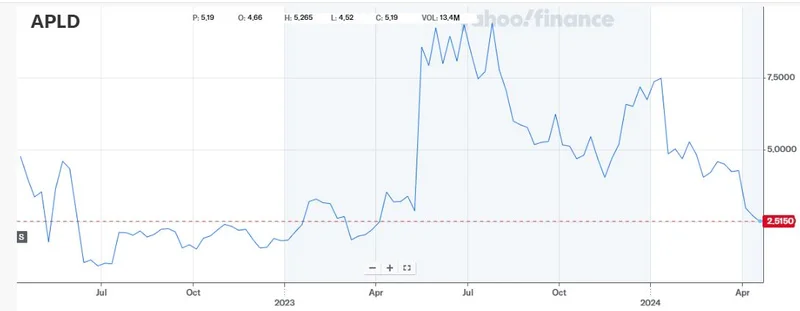Applied Digital Isn't Just Beating Earnings—It's Building the Engine of Tomorrow
I want you to forget the headline numbers for a second. Yes, Applied Digital just posted a staggering 84% year-over-year revenue increase, blowing past analyst expectations. And yes, if you’re only looking at the traditional Wall Street scorecard, you’ll see they missed their earnings-per-share target. Some outlets will focus on that, and frankly, they’re missing the entire point. They’re analyzing the paint job on a rocket ship while it’s busy achieving escape velocity.
What we’re seeing in this report isn’t about a single quarter’s profitability. It’s a dispatch from the front lines of the single greatest infrastructure build-out of our generation. When I read through documents like the Applied Digital Q1 FY2026 Reports Revenues $64.2M release, I honestly had to just sit back for a moment. This is the kind of progress that reminds me why I got into technology in the first place. This isn't a story about balance sheets; it's a story about pouring the concrete foundations for the future of artificial intelligence.
Applied Digital’s CEO, Wes Cummins, calls his company the "modern-day picks and shovels of the intelligence era." It’s a good line, but I think it might even be an understatement. This is more like building the national power grid for a new kind of electricity—the electricity of pure computation. They aren't just selling tools to the gold miners; they're building the entire territory where the gold rush is happening.
A Deal So Big It Bends Reality
Let’s get to the heart of it. The number that truly matters in this entire report is $11 billion. That’s the approximate value of the long-term revenue Applied Digital has now locked in with a single customer, CoreWeave, at its Polaris Forge 1 campus in North Dakota. This isn’t a projection or a hopeful estimate. It’s contracted, secured revenue over the next 15 years. The sheer scale of this is hard to wrap your head around—they signed an initial deal in May and have already expanded it to lease the entire 400-megawatt campus, a campus that is still being built, and this latest lease secures the final piece of that puzzle.
This is where we have to translate the jargon. CoreWeave is what we call a hyperscaler—in simpler terms, it's one of the massive companies that provides the foundational cloud computing power that runs huge swaths of the internet and, increasingly, the world's most demanding AI models. For a hyperscaler to commit this deeply to a partner like Applied Digital isn't just a vote of confidence; it’s a strategic marriage. It signals that Applied Digital’s model for building high-performance data centers isn't just viable; it's essential.

And they aren't stopping. They’ve already broken ground on a second campus, Polaris Forge 2, with plans to scale it to a mind-boggling one gigawatt of capacity. To put that in perspective, a gigawatt is enough energy to power roughly 750,000 homes. Imagine all that power, all that potential, focused on a single task: computation. This isn't just building another warehouse full of servers. This is the 21st-century equivalent of the Hoover Dam, a monumental engineering project designed to channel immense power into productive work that will redefine our world. When you’re building at that scale, are you really worried about a few cents on an EPS estimate? Or are you focused on laying the tracks for the next industrial revolution?
The Blueprint for a New Utility
What excites me most, beyond the jaw-dropping financials, is the vision. Applied Digital seems to understand that they are building a new kind of utility. Just as the transcontinental railroad connected the coasts and created a unified American economy, this new infrastructure—this "Intelligence Grid"—will connect ideas and data in ways we can barely begin to imagine. The company is laying down the physical substrate upon which the next generation of scientific discovery, artistic creation, and economic innovation will be built.
Of course, with great power comes immense responsibility. A one-gigawatt data center campus raises profound questions about energy consumption and environmental stewardship. This is the moment for ethical consideration. Are we building a sustainable future or just a faster one? I’m encouraged by Applied Digital’s focus on designs like their closed-loop, direct-to-chip liquid cooling system, which they claim uses less water than a single household and achieves a Power Usage Effectiveness—basically, a measure of energy efficiency—of 1.18. A perfectly efficient data center would be 1.0, so this is getting remarkably close to the theoretical limit.
They are building in North Dakota for a reason: abundant and low-cost energy, plus a climate that provides over 200 days of natural "free cooling" a year. This isn’t a happy accident; it’s a deliberate strategy. But as they scale from one campus to two, and potentially beyond, can they maintain this commitment? With hyperscalers lining up and capital flowing in, will the pressure to build faster compromise the mission to build smarter? That remains the critical question, the one that will define their legacy.
The financing they’ve secured, drawing from a massive $5 billion facility with Macquarie, shows that the world’s most serious infrastructure investors see what’s happening. This isn’t speculative venture capital anymore. This is patient, long-term capital that builds bridges, airports, and power plants. It’s a sign that the AI revolution has left the lab and is now being integrated into the very bedrock of our civilization.
The Future is Being Poured in Concrete
Let's be perfectly clear. We are witnessing a fundamental shift from a world where computing power was a scarce resource to one where it will become an abundant utility. Applied Digital isn't just a participant in this shift; it's one of its primary architects. Forget thinking of them as a tech company that has to hit quarterly earnings targets. Start thinking of them as an infrastructure company, building the very ground on which the next economy will stand. What they are doing in the plains of North Dakota today will enable the breakthroughs that will define our lives tomorrow.









